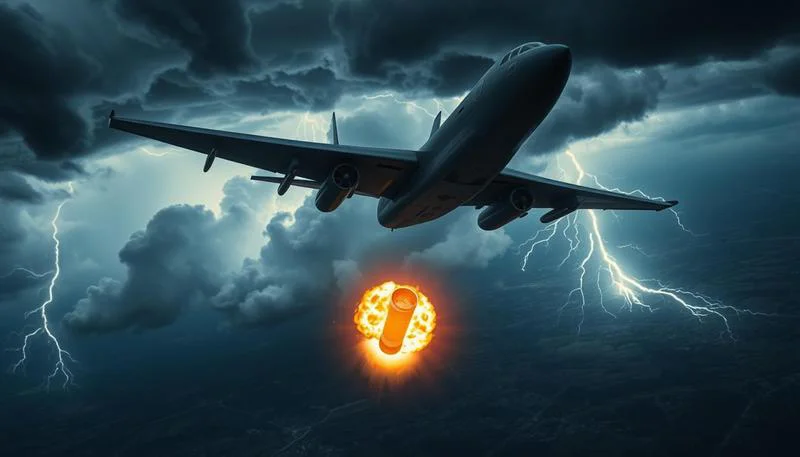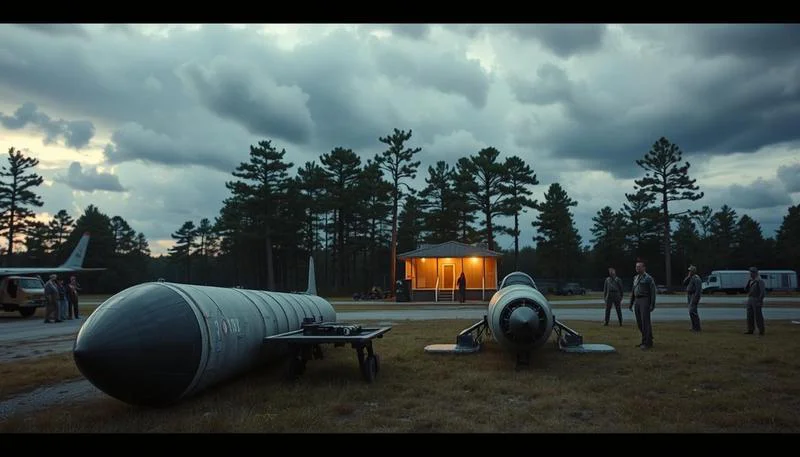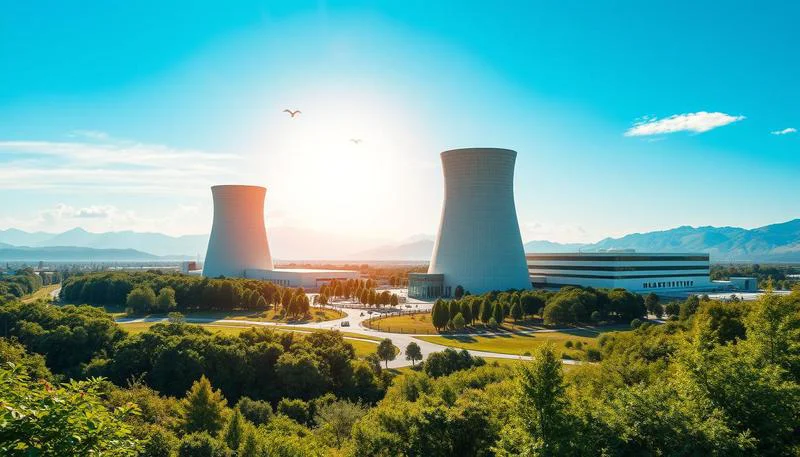The Broken Arrow incident is a dark chapter in nuclear history. It happened in 1961 and shows how close we came to disaster. This event reminds us of the risks of nuclear weapons and the importance of safety.

In North Carolina, a close call with nuclear weapons shook the nation. It showed how vulnerable these weapons are. This incident taught us the value of safety, emergency plans, and honesty in the nuclear field.
Key Takeaways
- The Broken Arrow incident in 1961 was a near-miss nuclear accident that nearly led to the detonation of a nuclear weapon on U.S. soil.
- This harrowing event underscored the critical need for robust safety measures and emergency response protocols in the handling of nuclear weapons.
- The incident sparked a renewed focus on transparency and accountability in the nuclear industry, leading to significant changes in the U.S. Air Force's nuclear weapons handling procedures.
- The Broken Arrow incident serves as a sobering reminder of the delicate balance between technological advancement and the potential for nuclear disaster.
- Lessons learned from this near-miss have shaped the way the U.S. approaches nuclear safety and security, helping to prevent similar catastrophic events in the future.
The Chilling Reality of Nuclear Accidents
The thought of a nuclear accident is terrifying. These mishaps are real and have left deep scars on history. The Chernobyl disaster and the Fukushima meltdown are examples of the devastating effects. They harm people and the environment worldwide.
Exploring the Potential Consequences of a Nuclear Mishap
A nuclear accident's effects are huge and scary. The first impact can be very bad, with radioactive materials causing harm and death. The long-term effects are even worse, with radiation lasting for years and causing more health problems.
The damage from a nuclear accident doesn't stop at the site. Radioactive particles can spread far, affecting many areas and countries. This would lead to big problems, like economic issues and strained relations between nations.
| Potential Consequences of a Nuclear Accident | Short-Term Impact | Long-Term Impact |
|---|---|---|
| Radioactive contamination | Immediate health risks, including radiation sickness and increased cancer rates | Persistent environmental contamination, long-term health effects, and economic disruption |
| Environmental damage | Immediate harm to wildlife and ecosystems | Lasting ecological consequences, including habitat destruction and biodiversity loss |
| Economic and social disruption | Evacuations, property damage, and disruption of essential services | Long-term economic recovery challenges, population displacement, and social upheaval |
A nuclear accident can have big effects that last long after the event. It's important to understand the risks and work on making nuclear plants safer. This can help prevent the worst of these disasters.
The Broken Arrow Incident: A Harrowing Tale
On January 23, 1961, North Carolina's skies were about to see a chilling moment. The Broken Arrow incident was a near-disaster that could have changed American history.
A United States Air Force B-52 bomber, carrying two hydrogen bombs, had a major failure in flight. It broke apart, and the bombs fell towards the ground, ready to explode.
"The Broken Arrow incident was a wake-up call for the American public, highlighting the very real and terrifying consequences of nuclear accidents."The bombs were racing towards the earth, and the Air Force had to act fast. They worked to find the bombs and secure the area. They knew a detonation could harm many people and the environment.
Fortunately, the bombs didn't explode when they hit the ground. But the Broken Arrow incident showed how dangerous nuclear power can be. It also showed the need for strict safety rules.
The Broken Arrow incident in North Carolina was a scary story of almost disaster. It made the U.S. rethink its nuclear safety and how it handles its nuclear weapons.
The U.S. Air Force's Nuclear Weapons Handling Procedures
The U.S. Air Force takes safety and security very seriously when dealing with nuclear weapons. They have strict rules and safeguards to avoid accidents. This ensures these weapons are used and stored safely.
Safeguards and Protocols to Prevent Nuclear Accidents
The Air Force's approach to safety is detailed and multi-layered. It includes strict training, following rules, and using extra safety features. Important safety steps include:
- Extensive background checks and security clearances for all personnel involved in nuclear weapons operations
- Thorough inspections and maintenance of nuclear weapon systems and storage facilities
- Redundant safety locks, switches, and failsafe mechanisms to prevent unintended detonation
- Robust physical security measures, such as armed guards and advanced surveillance systems
- Regular drills and emergency response exercises to ensure preparedness for potential incidents
The Air Force also focuses on ongoing training and following procedures. This reduces the chance of mistakes, which have led to accidents in the past.
| Safety Measure | Description |
|---|---|
| Personnel Vetting | Extensive background checks and security clearances for all personnel involved in nuclear weapons operations |
| Facility Inspections | Thorough inspections and maintenance of nuclear weapon systems and storage facilities |
| Technical Safeguards | Redundant safety locks, switches, and failsafe mechanisms to prevent unintended detonation |
| Physical Security | Robust physical security measures, such as armed guards and advanced surveillance systems |
| Emergency Preparedness | Regular drills and emergency response exercises to ensure preparedness for potential incidents |
These detailed nuclear safety protocols and nuclear weapons handling steps aim to lower the risk of nuclear accidents. They ensure these weapons are handled responsibly.
When the U.S. Almost Nuked Itself: The North Carolina 'Broken Arrow' Incident
The 1961 north carolina nuclear incident is a stark reminder of the dangers of nuclear weapons. It happened in a remote area of North Carolina. A U.S. Air Force B-52 bomber broke apart in mid-air, releasing two nuclear bombs.
The events leading up to this disaster were both chilling and complex. One bomb fell safely, thanks to its parachute. The other bomb had a series of mishaps, almost detonating and causing a huge explosion.
"The Broken Arrow incident is a stark illustration of the delicate balance between technological advancement and human error, underscoring the necessity for robust safety measures in the handling of nuclear weapons."Luck and the bravery of local authorities and U.S. military personnel saved the day. The bomb's safety features worked, preventing a full detonation. This saved the area from radioactive contamination.
This close call highlights the risks of nuclear accidents. It shows how crucial it is to keep nuclear safety at the highest level. The north carolina nuclear incident teaches us to stay vigilant and follow strict safety protocols to avoid future disasters.

The Aftermath: Cleanup and Containment Efforts
The Broken Arrow incident in North Carolina was a chilling reminder of the potential hazards of nuclear accidents. After the incident, a big cleanup and containment effort was started. This was to lessen the environmental and health risks from the nuclear weapon's near-detonation.
Mitigating the Environmental and Health Risks
A team of experts from the U.S. Air Force, the Atomic Energy Commission, and government agencies worked together. They worked hard to secure the site, contain any radioactive materials, and stop further contamination. The nuclear incident cleanup needed careful procedures and special equipment to keep workers and the community safe.
One big worry was the environmental impact of nuclear accidents. The team checked the soil, air, and groundwater for radioactive substances. They took steps to keep the affected areas isolated and stop contaminants from spreading.
- Soil samples were collected and analyzed to find out how bad the contamination was.
- Monitoring stations were set up to watch radiation levels and air quality in the area.
- Groundwater wells were tested to make sure the local water was safe.
The cleanup faced challenges, like complex logistics and keeping workers safe. But the team's hard work and knowledge were key in reducing the risks from the Broken Arrow incident.
The aftermath of the Broken Arrow incident shows how important being ready and having strict safety rules are in the nuclear industry. The lessons from this event help improve nuclear safety and prevent future incidents.
Nuclear Safety and Transparency: Lessons Learned
The Broken Arrow incident was a wake-up call for the nuclear industry. It showed the need for strong nuclear safety and nuclear transparency practices. After this close call, leaders worked hard to fix mistakes and make big changes to keep everyone safe.
One big lesson was the need for careful handling of nuclear weapons. The U.S. Air Force reviewed its safety rules after the incident. They made training better, kept equipment in top shape, and planned for emergencies.
- Improved safety protocols for the transportation, storage, and handling of nuclear materials
- Enhanced security measures to prevent unauthorized access or tampering with nuclear weapons
- Increased emphasis on regular safety inspections and maintenance of nuclear facilities
The Broken Arrow incident also led to more nuclear transparency. Leaders wanted to win back the public's trust. The incident had shaken people's faith in the nuclear industry.
"The Broken Arrow incident exposed the urgent need for the nuclear industry to be more accountable and transparent in its operations. This was a watershed moment that set the stage for sweeping reforms to enhance safety and rebuild public trust."So, the industry started to share more information and listen to the public. They did this by:
- Reporting more on nuclear safety incidents and near-misses
- Working with independent groups to check on nuclear operations
- Creating ways for the public to get information and share concerns
The lessons learned from Broken Arrow have changed the nuclear industry. They've made a commitment to always improve and be open about nuclear safety and nuclear transparency. By fixing past mistakes, the industry is working hard to avoid future problems and regain public trust.

Preventing Future Nuclear Incidents: Stricter Regulations
After the Broken Arrow incident, there's a big push for stricter rules and better safety. The goal is to lower the risk of nuclear accidents. This will keep people and the environment safe.
Enhancing Safety Measures and Emergency Response Plans
Improving safety and emergency plans is key to avoiding future nuclear disasters. This includes:
- Training and certifying nuclear facility workers to keep them safe and skilled.
- Checking and fixing equipment to find and fix any weak spots in nuclear systems.
- Creating detailed emergency plans for quick action in case of an accident.
- Working better together between government, local groups, and emergency teams.
These steps, along with stricter rules, aim to make a safer system. This system can handle and lessen the effects of a nuclear accident.
| Safety Measure | Description |
|---|---|
| Personnel Training | Rigorous training programs to ensure nuclear facility staff maintain the highest levels of operational expertise and safety awareness. |
| Equipment Inspections | Regular inspections and maintenance of nuclear weapons and transportation systems to identify and address potential vulnerabilities. |
| Emergency Response Plans | Comprehensive plans outlining clear procedures for emergency containment, evacuation, and post-incident recovery efforts. |
| Interagency Coordination | Strengthened collaboration and communication between government agencies, local authorities, and emergency services to ensure a coordinated response. |
By taking these strong steps, we can lower the chance of nuclear accidents. This will help keep everyone and the environment safe from the harm of such events.
The Lasting Impact of the Broken Arrow Incident
The Broken Arrow incident was a close call that could have led to a nuclear disaster. It has changed how people view nuclear safety. This event has also shaped how we manage and secure nuclear weapons.
The incident led to a big change in how the U.S. Air Force handles nuclear weapons. They now have stricter safety rules and better training for those working with these weapons. This focus on safety is key to preventing accidents and handling these powerful weapons responsibly.
The Broken Arrow incident has also made people more aware of nuclear issues. It showed us how dangerous a mistake can be when dealing with nuclear weapons. This awareness has led to more calls for safety, transparency, and accountability in nuclear policy. It has shaped our national conversation about nuclear technology's role in today's world.
FAQ
What is the Broken Arrow incident?
The Broken Arrow incident was a close call in 1961. It happened in North Carolina. The U.S. almost faced a huge nuclear disaster.
What were the potential consequences of the Broken Arrow incident?
If it had happened, it could have been very bad. There could have been a lot of radioactive pollution. This would have harmed the environment and many people.
How did the U.S. Air Force handle nuclear weapons at the time of the Broken Arrow incident?
The U.S. Air Force had rules for nuclear weapons. But, the Broken Arrow incident showed it's hard to keep everything safe all the time.
What was the cleanup and containment effort following the Broken Arrow incident?
After the incident, a big effort was made to clean up. Authorities worked hard to reduce the risks of nuclear pollution.
How did the Broken Arrow incident impact nuclear safety and transparency?
It made everyone wake up. It led to better rules and safety plans. It also made the nuclear industry more open.
What is the lasting impact of the Broken Arrow incident?
It changed how we think about nuclear safety. It's a reminder to always work on making things safer. It pushes us to keep improving.

